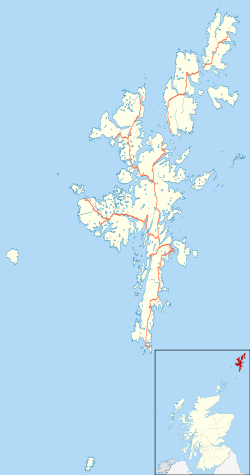 Aerial view of the archaeological dig | |
| Location | Mainland, Shetland |
|---|---|
| Coordinates | 59°52′44″N1°18′19″W / 59.879°N 1.3054°W |
| Type | Broch and settlement |
| History | |
| Periods | Iron Age, Pictish, Viking |
Old Scatness is an archeological site on Scat Ness, near the village of Scatness, in the parish of Dunrossness in the south end of Mainland, Shetland, Scotland, near Sumburgh Airport. It consists of medieval, Viking, Pictish, and Iron Age remains and has been a settlement for thousands of years, each new generation adding buildings, and levelling off old ones. Among the discoveries is an Iron Age broch, the Ness of Burgi fort.

